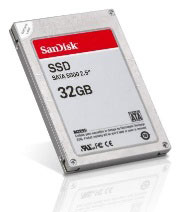 SanDisk today added a 32GB, 2.5-inch Serial ATA solid state drive (SSD) to its notebook product line. The new drive is compatible with most mainstream notebooks and is a direct replacement for hard disk drives.
SanDisk today added a 32GB, 2.5-inch Serial ATA solid state drive (SSD) to its notebook product line. The new drive is compatible with most mainstream notebooks and is a direct replacement for hard disk drives.
“The SanDisk 2.5-inch SSD brings the extreme durability, outstanding performance and low power consumption of solid-state flash memory to the entire notebook computer market,” said Amos Marom, vice president and general manager of the Computing Systems division at SanDisk. “As SanDisk continues to drive innovation in flash memory, the per-gigabyte price of SSD storage will come down and SSD capacity will go up. PC manufacturers and consumers will find it easier and easier to move away from rotating hard disks to the superior experience of SSDs.”
Notebook manufacturers will have to pony up $350 per 32GB SSD, far more than high capacity hard drives. But there are several benefits to replacing rotational notebook drives with SSDs. There are several applications where reliability and durability are more important than price-per-GB and larger storage capacity.
SanDisk says SSDs have the following benefits:
- Reliability. SanDisk SSDs deliver 2 million hours mean time between failures, approximately six times more than notebook hard disks. With no moving parts, SanDisk SSDs are also much less likely to fail when a notebook computer is dropped or exposed to extreme temperatures.
- Performance. In notebook computers, data moves to and from a SSD more than 100 times faster than data moving to and from a hard disk. SanDisk SSDs offer a sustained read rate of 67 megabytes (MB) per second and a random read rate of 7,000 inputs/outputs per second (IOPS) for a 512-byte transfer. As a result, notebooks equipped with a 2.5-inch SanDisk SSD can boot Microsoft Windows Vista Enterprise in as little as 30 seconds and access files at an average speed of 0.11 milliseconds. A notebook using a hard disk requires an average 48 seconds to boot and an average 17 milliseconds to access files.
- Power efficiency. SanDisk SSDs have minimal power requirements, with savings rated at over 50 percent compared with a hard disk drive — 0.9 watts during active operation versus 1.9 watts. This is particularly important in extending battery life for road warriors, enabling them to remain productive while in transit.
- Cool and quiet. Because SanDisk SSDs donâ€Ëœt need a motor, bearings or a moving head mechanism, they generate much less heat than hard disk drives. SanDisk SSDs are also completely silent, while hard disk drives always make at least some noise during read and write operations.
Gartner research projects global consumption of Solid State Drives will increase from approximately 4 million units in 2007 to 32 million units in 2010.
“There are several reasons computer users and manufacturers should consider SSDs as prices become more affordable,â€Å said Joseph Unsworth, Principal Research Analyst for flash memory at the Gartner research firm. âہFor example, Gartner research shows hard disk failure is tied for first place with motherboard failure as the leading cause of overall hardware failure in notebooks, with each accounting for 25 to 45 percent of the total.”
Average consumers and most business users should steer clear of SSDs unless they have a distinct need for them for the time being. The gap between HDD and SSD capacities and price is too great to justify.